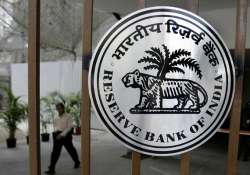RBI may hold rates until second quarter of 2015: Poll
Bangalore: The Reserve Bank of India (RBI) will probably wait until the second quarter of next year to loosen policy as it wants to cool inflation before trying to spur growth, a poll found ahead

Bangalore: The Reserve Bank of India (RBI) will probably wait until the second quarter of next year to loosen policy as it wants to cool inflation before trying to spur growth, a poll found ahead of a policy review meeting next week.
All but three of 46 economists surveyed over the past week said the bank would leave its key repo rate unchanged at 8.0 per cent when it meets on September 30.
The survey showed that the RBI is also unlikely to alter either the statutory liquidity ratio (SLR), setting banks` minimum bond holding requirements, or the cash reserve ratio (CRR) that sets the percentage of depositors` balances that banks must keep with the central bank.
And 16 of 21 economists polled said it will not cut the ceiling on debt that must be held-to-maturity (HTM).
Analysts also pushed back expectations for when the first interest rate cut is likely to happen.
The poll shows they now think the first 25 basis point cut in the repo rate will come between April and June next year, three months later than they had predicted in a July poll.
That would coincide with expectations of the first rate hike by the US Federal Reserve, in a move that would start pulling the curtain down on almost five years of nearly zero per cent interest rates and trillions of dollars spent on stimulus.
From there on, the RBI is expected to gradually cut the repo rate to 7.00 per cent by mid-2016.
"From the commentary of Governor Raghuram Rajan it was very clear that inflation remains the focus," said Bhupesh Bameta, economist at Quant Capital.
"That gives us more confidence that instead of the first quarter the first rate cut will be shifted to the second quarter," Bameta added.
At an RBI meeting in early August, Rajan reaffirmed his commitment to bringing down inflation and said it was "appropriate to continue maintaining a vigilant monetary policy stance".
Consumer price inflation cooled to 7.80 per cent in August from 7.96 per cent in July.
But, it is still far higher than the 6 per cent level the RBI wants it at by January 2016, and as risks of a temporary spike from escalating food prices still exist three economists expect a hike in the repo rate in the next six months.
Sluggish investments, stalled projects, government policy paralysis and high interest rates meant India`s economic growth has been running at a shadow of the near double-digit levels seen in 2010.
In the quarter ended in June, the lumbering economy notched its fastest growth in two-and-a-half years, accelerating to 5.7 per cent to raise hopes that the worst was over.
Stock markets have rallied since Prime Minister Narendra Modi took charge in May on hopes his government will rapidly usher in reforms and attract foreign investment.
But New Delhi`s failure to introduce any big-ticket reforms has dented much of that optimism, putting a spotlight back on the RBI to help boost growth through credit and interest rates.
"Governor Rajan is acutely aware of the trade-off in growth, but what he is trying to achieve is the credibility of inflation targeting," said Vishnu Varathan, senior economist at Mizuho Bank in Singapore.